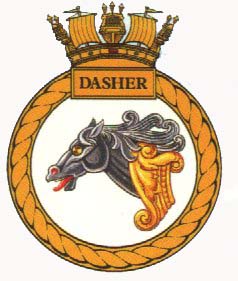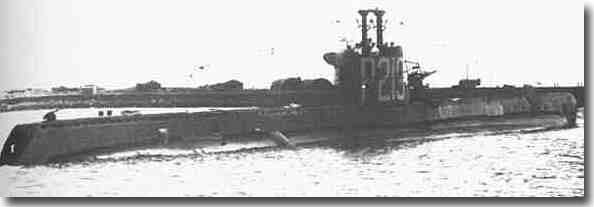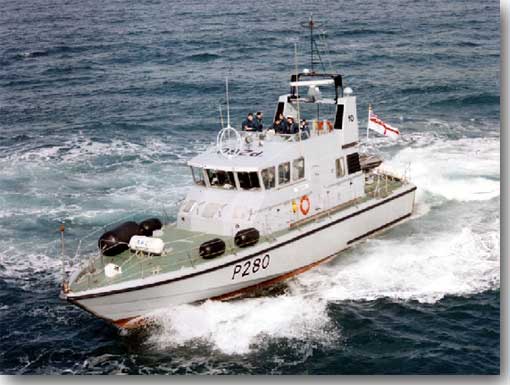|
Archer Class Auxiliary Carrier, HMS Dasher Destroyed by Explosion on the 27nd. of March 1943. 379 Dead
See "Photos about the Memorial Service for Dasher"
Introduction. It was desperate times and the Auxiliary Aircraft was spawned. Six of these vessels were built under the Lend Leas Agreement with the United States, by adding a flight deck to existing Merchant Ship hulls, thus bringing to fruition the concept of the Auxiliary Carrier which carried up to 16 aircraft. Building and Commissioning Dasher. The 7,866 ton,dead weight ship was 492 feet long, with a 68.5 foot beam, drawing 25.5 feet. Her crew about 520, and the armament, a 4.7 inch Low Angle / High Angle gun, 8 by 40mm, and 12 by 20mm weapons, speed 16 knots, and carrying up to 16 Swordfish and Sea Hurricane aircraft.
The Clyde was made safely by the 10th. of September, and a number of modifications were needed to be made to fuel storage tanks and ammunition magazines. On the 15th. of October Sea Hurricanes and Swordfish aircraft from Squadron 891 were flown on board, and ten days later, Sea Hurricanes from Squadron 804 flew on. Operation Torch. Dasher at 0400 on the 8th. of November 1942, became a part of the first Allied combined operation of WW2 by launching 6 Sea Hurricanes, their task to escort and defend an air attack on Oran airfield. On their return, haze prevented them in finding the ship, 3 made forced landing ashore, 2 were lost together with their pilots, the 6th, was involved in a dogfight with a Vichy aircraft, and was forced to land in enemy territory, the pilot a POW, not an auspicious beginning for the Fleet airarm personnel and their planes. Dasher was forced to seek engine repairs at the Naval Dockyard at Gibraltar, and then sailed back to Liverpool, once more engine repairs were necessary. HMS Avenger, a sister ship had been lost, causing modifications to be made to the bomb room of Dasher, the ship was spending more time in Dock Yard hands than in doing the job she was designed for, namely convoy protection. Scapa Flow and a Russian Convoy.
On the 15th. of February, Dasher joined Convoy JW 53 at Lock Ewe, their destination Murmansk, North Russia. 28 Royal Navy ships made up the protection force, and atrocious weather beckoned. Sixty foot waves, gale force winds tossed the ill equipped Auxiliary Carrier around like a small cork in the raging storm, 6 merchant ships turned back, HMS Sheffield had a gun turret smashed away by the heavy seas, it was one of the worst storms recorded in WW2. The flight deck and hangar were no places to be in, aircraft broke free from their lashings, and disappeared from the flight deck, in the hangar they ran amok, crashing into each other. The hangar had to be declared out of bounds. In the torpedo room, a torpedo broke clear from its stowage, creating havoc as it rolled free from port to starboard with every pitch of the ship. Split in Dasher's side. After being examined this ship was declared unfit for active service, she was escorted by the destroyer HMS Blankney to Dundee where repairs would be made, and the aircraft replaced. Anyone serving in this ill fated vessel must have thought her an "ABSOLUTE LEMON." Repairs at Dundee. Whilst at the ship yard a fire broke out in the aircraft lift shaft, caused by overloading the lift, the resistors in the electronics becoming red hot and igniting a discarded oil rag in the lift shaft. More repairs were made, and the ship was sailed to Rosyth, to dock to check her hull, all was well, and the ship made it to the safety of the Clyde. Working up the Squadrons. The ship was due at the Clyde by 1800 ( 6 PM ) and the Captain announced that leave would be granted to non-duty crew. The sailors were happy as they prepared for a run ashore at Greenock. Horrendous explosion. Holes were rent in the ship's side as she listed 10 degrees to starboard. The Captain ordered "ABANDON SHIP." Dasher's position was 205 degrees 5 miles from Cumbrie Island light, within 8 minutes the ship had sunk, sitting upright with the flight deck about 130 metres below the surface. The rescue. Of the ship's company of 527, two small coastal vessels Gragsman and Lithium, picked up 14 ( 3 later died ) and 60 respectively, and another 35 were rescued by the radar training ship, Isle of Sark, 3 of whom died on board, the French La Capricieuse managed to recover 26 from the blazing sea. These rescue operations were made vey difficult as the oil covered survivors slipped from the grasp of the would be saviours. Surivors and those who came to their aid, were warned not to talk about the disaster. The survivors, and there were only 149 of them, and 23 dead were brought ashore for identification, together with those who went to their aid, all were sternly warned not to talk to anyone about this disaster. This seemed a strange reaction by the authorities, what was the problem? was there some reason for such a reaction, and what appears to be a cover up? 72% of the crew had gone missing! These were made up of:
Telegrams despatched. Burials.
Four families claimed the bodies of their loved one to be taken home for a private burial, they were:
The Royal Navy held a funeral service in the Greenock Cemetery where six more victims of the Dasher explosion were laid to rest, and they were:
There was one more funeral service for William Macdonald, an Air Mechanic. He was unfortunate by being blown through a hole in the ship's side for a distance of 400 yards, he was picked out of the water by Motor Launch 528, and landed at HMS Fortitude, he languished in the Sick Bay there for 13 days, his burns too extensive to move him to the Ballochmyle Hospital. His parents travelled from the North of Scotland to maintain a vigil at his bedside, but he finally lost his battle and died. He was buried with his 12 former shipmates in Ardrossan Cemetery. Lack of information for the survivors. Security reigned over the whole sorry affair, but WHY? The Man that never was. Operation Mincemeat. The body was said to have been a tramp who had died from taking rat poison, and it was put into cold storage in Hackney mortuary. The body should appear to be that of an Officer who had drowned. How to deliver this body? A Royal Navy submarine was the perfect answer. It could surface close to land, and then the late Major Martin could be lowered from the open deck of the submarine into the water, consistent with his accidental drowning. It was decided that the best location was at Huelva in Southern Spain, British Intelligence were aware that a German agent operated there. With the right tide calculation, Major Martin's body could be washed up to be found by the Spaniards, who would inform the German agent of their find, with a briefcase locked to his wrist, hopefully its contents soon on its way to Berlin. The body would need to be suitably dressed, wearing a Mae West life jacket, around his neck was a silver cross on a silver chain. An identity disc was attached to his braces, it carried the engraving: Major W Martin, RM. R/C. It was important that this body was taken for a Roman Catholic, as it was considered unlikely that the Spanish authorities would carry out a proper post mortem upon a Roman Catholic. Hopefully, only a medical examination would take place before the body received a burial. In his possession was some loose change, a bunch of keys, a box of matches, cigarettes, letters from his father and his solicitor. To fabricate his private life, an Admiralty secretary posing as his financee, wrote two very personal letters to Major Martin. The final touch was a letter from Lloyd's Bank of 731 Lombard Street, London, asking for prompt payment of a 79 Pound overdraft, and in his wallet was a bill from the Navy and Military Club. Obviously a graet deal of thought had gone into setting up this huge deception. Within the chained brief case were the Top Secret papers indicating the invasion would take place on Greek Islands. To back them up were three very important letters, two supposedly from Lord Louis Mountbatten, one addressed to General Eisenhower, the other to the Admiral of the Fleet. The final letter was from Lieutenant General Nye to General Alexander, who was Eisenhower's deputy. Personal papers identified the body as Major William Martin, Royal Marines, Military Serial Number 148228. Age 36.
Commanding Officer of HM Submarine Seraph summoned to London. Lieutenant Jewell met with Lieutenant Ewan Montagu on the 31st. of March 1943, the day 12 of Dasher's crew were buried at Argrossan, and by chance Major Martin's Combined Operations Headquarter's pass was stamped " Not Valid after 31 March 1943." At this meeting, Jewell was ordered to sail his submarine from Blythe, on the north east coast of England, to the Holy Loch in the Clyde, but 8 miles from where Dasher had sunk. The body of the Major in a special container was reported on its way northwards in an unmarked truck, to be collected by Jewell in his boat Seraph. Why sail Seraph from the east coast around Pentland Firth, down the west coast to the Clyde? Why was it necessary to sail Seraph up the Scottish east coast, around the top of Scotland, and down the west coast to the Clyde to collect a body en route by truck from London? It would have made much more sense to drive the body straight to Blythe where Seraph was berthed.
HM Submarine Seraph who carried the body of the supposed Major William Martin to Southern Spain from the Clyde in 1943.
Body Swap. But why? Unless it had been decided to replace the tramp's body with one from the Dasher tragedy. Did the truck from London bear an empty container, which was now destined to be used for a body ex Dasher? Why else would Lieutenant Jewell with his submarine Seraph be flogging up the east coast of Scotland, around the north of Scotland and then turn south and make for the Clyde? The latest research by the authors, John Steele and Noreen Steele of the book " The Secrets of HMS Dasher." Published by Argyll Publishers of Argyll, in a Third Edition of 2002, would seem to confirm that this is what did take place back in 1943. Seraph drops a body off Huelva Beach. Seraph proceeded to Gibraltar. When the boat reached the shore the Marine Judge, Pascual El Rafeno was sent for, he inspected the corpse and gave approval for its transport via a donkey to Punta Umbria where a small ferry took Major Martin's body to Huelva. Judge takes possession of the locked briefcase. German agent in Huelva. The body was entrusted to the British Vice Consul, but no mention was made about the fact that when found there was a brief case fastened to a wrist, in fact, this case and its contents were already on their way to the Spanish Foreign Ministry in Madrid. The Vice Consul arranged for a Spanish pathologist Eduardo Del Torno to carry out a Post Mortem at the Heuelva Mortuary next to the cemetery. This pathologist notes: " The man had fallen into the sea while still alive and had no bruises, death was due to drowning. Hos body has been in the sea between 3 and 5 days." A funeral service was now held at the Huelva Cemetery for Major Martin the next day. On the Admiralty in London becoming aware that Major Martin had officially " drowned" instructions were issued that a headstone was to be erected at the grave site with this wording: William Martin Born 29th. March 1907 Died 24th. April 1943. Beloved son of John Glyndwyr Martin and the late Antonia Martin of Cardiff, Wales. R.I.P. All appeared to have gone absolutely as planned, now it remained to ascertain if the High Command in Germany had taken the bait. The answer came in weeks. The Foreign Office in Spain, had opened the Documents found in the brief case, copied and resealed them, and then handed them all back to the British Vice Cousul. Senior Jornana, the Spanish Foreign Minister took this information as being totally reliable, that the Allies main attack would take pace against Crete and the Peloponnesian Islands. This information was immediately passed on to German Miliatry Intelligence who also accepted the documents as genuine, the German Hight Command responded by moving their troops away from Sicily. London received reports that thousands of German troops that included Panzer Divisions, heavy artillery, a Torpedo Boat flotilla, and aircraft from the Luftwaffe, were all withdrawn from the proposed invasion site at Sicily. Even at this distance in time, one can certainly hear the chuckle from Winston Churchill, as he was delighted to have fooled both Hitler and his High Command with this successful deception. Allies Invade Sicily on the 10th. of July in 1943. Who was Major Martin? The War Graves Commission in 1998 asked the Southern Spanish Branch of the British Legion to have a monumental mason engrave the following on the gravesite at Huela:
The Commanding Officer of the Royal Navy Submarine Seraph was traced when a Retired Admiral, Norman Jewell recalled removing the body from the metal cannister and placing it in the sea back in 1943. About the body, he stated:
A lady who had been part of the original Intelligence team in planning the deception, when questioned about the body used, said she was still bound by the Official Secrets Act, but "However more than one body was used." A most significant statement! Original body. It was thus necessary to come up with a fresh body that had in fact expired through drowning. Where better to acquire such a body, than from those who had died as a result of the Dasher explosion? It is my firm view, that is exactly what happened, and the RN submarine Seraph was diverted from her base on the east coast of England round the north of Scotland, down to the Clyde, just after this tragic accident, and WHY? To collect a fresh drowned body. Cause of the Explosion in Dasher. The lighting system was not up to the magazine lighting specification, a fault on this system could have ignited petrol vapour when the lights were activated. All in all, a very sloppy set of circumstances, that when an explosion from whatever cause did happen, it triggered a tragedy and 379 crew died. Was there a cover up? Memorial Plaque laid on the flight deck of the sunken Dasher. DEDICATED TO THE MEMORY OF THE 379 MEN WHO PERISHED WHEN HMS DASHER BLEW UP AND SANK ON 27TH. OF MARCH 1943. The current HMS Dasher, a patrol boat, serving in Cyprus was the venue for a memorial service in October 2004, held for John Melville who at age 37 perished when the Auxiliary carrier HMS Dasher blew up in the Clyde Estuary in 1943. At that time it was believed his body had come ashore at Ardrossan to be buried in the local cemetery with full Naval Honours. His daughter, Mrs Mackay from Galashiels, had mourned her Father at a Scottish grave, whereas his body was probably buried many miles away in Southern Spain. Lieutenant Commander Mark Hill, CO of the Naval Squadron in Cyprus told Mrs Mackay
Mrs Mackay, now 64, said: " I feel honoured if my Father saved 30,000 Allied lives." Conclusion. But, as later reported, to save some 30,000 Allied lives in the Sicily invasion, many will agree, justifies the secrecy. Individuals must make their own judgement on this operation.
The current HMS Dasher, the 5th. ship to carry this name. |


 A great deal of trouble was experienced in starting her engines, they back fired, and her Chief Engineer had little faith in the design of the Sun Droxford engine, as the ship due to engine defects failed to sail as planned. Eventually at the third attempt the engines did start, and at last, Dasher departed Boston with a convoy bound for Halifax on the 30th. of August, 1942.
A great deal of trouble was experienced in starting her engines, they back fired, and her Chief Engineer had little faith in the design of the Sun Droxford engine, as the ship due to engine defects failed to sail as planned. Eventually at the third attempt the engines did start, and at last, Dasher departed Boston with a convoy bound for Halifax on the 30th. of August, 1942.


